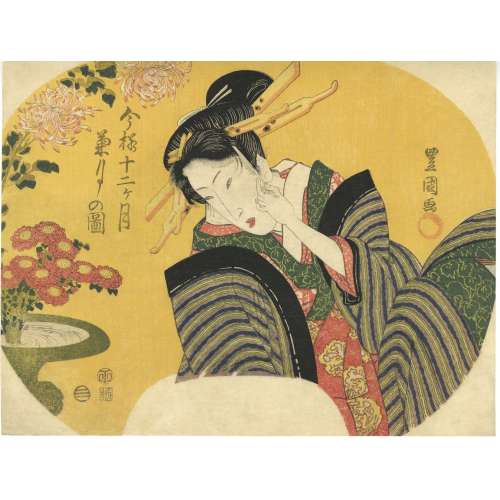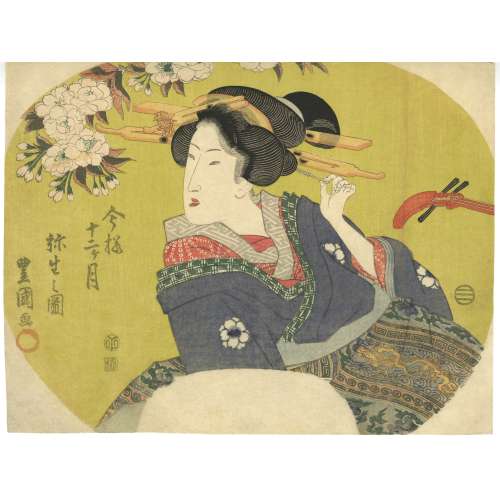Artist:
Utagawa Kunisada [歌川 国貞] a.k.a. Utagawa Toyokuni III [三代歌川豊国] (Japanese, 1786 – 1865).
Signed:
Toyokuni ga [豊国 画] in a red toshidama cartouche.
Publisher: Ibaya Senzaburō [伊場屋仙三郎] (Japanese, c. 1815 – 1869).
Double nanushi censor seals: Hama & Magome, Kaei 2-5 (1849 – 1852).
An uncut fan print (uchiwa-e, 220 x 292 mm) depicts a beautiful woman sitting on a balcony overlooking a bay and reading a book. Above the book, there is an obi with a pattern of stripes or modified key fret motif, with lettering that reads: 菅原島 [Sugawara-jima] and 美立 [mitate]. The lettering and the blossoming plum branch next to the obi provide an allusion to
Sugawara no Michizane [
菅原 道真/菅原 道眞] (Japanese, 845 – 903) - a prominent scholar and poet of Heian period exiled from Kyoto to the island of Kyushu as a result of another courtier's slander. A legend says that his beloved plum tree was so fond of its master that it flew to Kyushu with Sugawara.
The Davis Museum at Wellesley College describes the print as belonging to the series A Parody of Sugawara Stripe Patterns (Mitate Sugawara-jima).
To make the fact of an allusion transparent, Kunisada had changed the usual way of writing "Sugawara stripes" from 菅原縞 to 菅原島 and "mitate" from 見立 to 美立. An unusual spelling was also used to provide additional information to the reader in other cultures. E.g. during the Prohibition Era, the West Coast United States speakeasy bars and bordellos misspelt the items on a menu ("scollops") or in a neon sign ("Martuni's") to tell: here we have more pleasures for you than you may have expected. After
Tenpō reforms, the printing of bijin-ga (
美人画, "picture of beautiful woman") images was restricted. Our print disguises a typical bijin-ga as an advertisement of an obi (帯, a kimono sash) fabric pattern. "The market of portraits was satisfied and the authorities fooled" [Rebecca Salter. Japanese popular prints. — Honolulu: University of Hawaii Press, 2006].

























